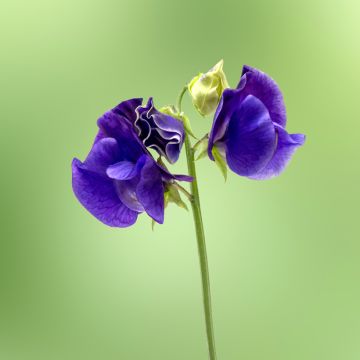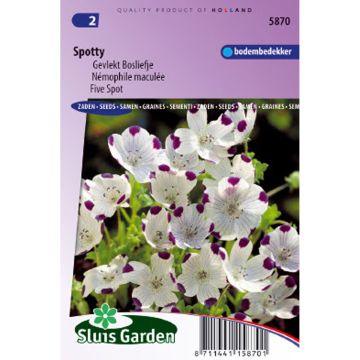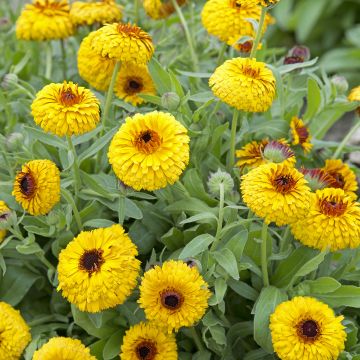

Seeds of Eryngium giganteum Miss Willmotts Ghost - Giant Sea Holly


Seeds of Eryngium giganteum Miss Willmotts Ghost - Giant Sea Holly
Seeds of Eryngium giganteum Miss Willmotts Ghost - Giant Sea Holly
Eryngium giganteum Miss Willmotts Ghost
Giant Sea Holly
Packet arrived intact - growth to be monitored after sowing and planting.
Sylvie D., 24/02/2018
This plant carries a 6 months recovery warranty
More information
We guarantee the quality of our plants for a full growing cycle, and will replace at our expense any plant that fails to recover under normal climatic and planting conditions.
Seed-only orders are dispatched by sealed envelope. The delivery charge for seed-only orders is €3.90.
Does this plant fit my garden?
Set up your Plantfit profile →
Description
Eryngium giganteum 'Miss Willmott's Ghost', also known as Giant Sea Holly, is a large thistle, typically biennial, that forms clumps of vibrant green heart-shaped foliage that turns silver in summer. It displays large clusters of steel blue or soft green conical heads, surrounded by beautifully serrated and silver bracts, very spiny. This plant often dies after flowering, but self-seeds spontaneously in light soil. Perfect in wildflower beds, in fresh or dried bouquets, of great ornamental value, it enjoys sun and well-drained, deep, even dry, rocky and poor soils.
Giant Sea Holly is a plant of the Apiaceae family (Umbelliferae), native to the Caucasus and Iran. Hardy down to -20°C, this blue thistle develops a rosette of deciduous, basal, heart-shaped leaves, medium green with white veins, which turn more greyish with heat. In July, bluish-grey inflorescences at maturity form conical and spiny cylinders 10cm (3.9in) long, accompanied by cut, leathery, silver bracts also 10cm (3.9in) long, all on stiff and branched stems. The dried flowers hold up well in dried bouquets. This short-lived perennial plant, often semelparous, readily self-seeds in rocky and deep soils.
Eryngium giganteum is well suited for rock gardens, flower beds or wild gardens, alongside Dianthus, Perovskia, and Stipa. This plant is beautiful everywhere, without overshadowing other blooms. Its rapid growth is a blessing for brand new gardens, or to fill the spaces left empty by a harsh winter. The semi-open cut flowers are splendid in dried bouquets, and make wonderful table decorations for Christmas.
Report an error about the product description
Flowering
Foliage
Plant habit
Botanical data
Eryngium
giganteum
Miss Willmotts Ghost
Apiaceae
Giant Sea Holly
Cultivar or hybrid
Other Thompson and Morgan seeds
Planting and care
Sow Eryngium seeds from February to July, in trays, pots, etc. in a special sowing compost that you place in a propagator or a warm place to maintain an optimal temperature of 18-20°C. Cover the seeds with a thin film of vermiculite or compost. Do not exclude light. Germination can be slow. Enclose the sowing in a polyethylene bag and keep at 15-18°C for 2 weeks, then place it in the refrigerator (not the freezer) for 3 to 6 weeks. After this step, bring the sowing back to the recommended temperature for germination. If germination does not occur within 6 to 10 weeks, place it back in the refrigerator for another 3 to 6 weeks.
Regularly check your stored seeds in the refrigerator and immediately remove seeds showing signs of germination.
Transplant the young plants when they are large enough to handle into 8cm (3.1in) diameter pots. Let them grow in a cold frame and plant them in the garden the following spring. Maintain a spacing of 30cm (11.8in) between each plant. Choose a sunny exposure and well-drained soil.
Cultivation: Eryngium giganteum grows in deep, dry, well-drained soil, even poor and rocky in hot and sunny situations.
Sowing period
Intended location
-
, onOrder confirmed
Reply from on Promesse de fleurs
Flower seeds
Haven't found what you were looking for?
Hardiness is the lowest winter temperature a plant can endure without suffering serious damage or even dying. However, hardiness is affected by location (a sheltered area, such as a patio), protection (winter cover) and soil type (hardiness is improved by well-drained soil).

Photo Sharing Terms & Conditions
In order to encourage gardeners to interact and share their experiences, Promesse de fleurs offers various media enabling content to be uploaded onto its Site - in particular via the ‘Photo sharing’ module.
The User agrees to refrain from:
- Posting any content that is illegal, prejudicial, insulting, racist, inciteful to hatred, revisionist, contrary to public decency, that infringes on privacy or on the privacy rights of third parties, in particular the publicity rights of persons and goods, intellectual property rights, or the right to privacy.
- Submitting content on behalf of a third party;
- Impersonate the identity of a third party and/or publish any personal information about a third party;
In general, the User undertakes to refrain from any unethical behaviour.
All Content (in particular text, comments, files, images, photos, videos, creative works, etc.), which may be subject to property or intellectual property rights, image or other private rights, shall remain the property of the User, subject to the limited rights granted by the terms of the licence granted by Promesse de fleurs as stated below. Users are at liberty to publish or not to publish such Content on the Site, notably via the ‘Photo Sharing’ facility, and accept that this Content shall be made public and freely accessible, notably on the Internet.
Users further acknowledge, undertake to have ,and guarantee that they hold all necessary rights and permissions to publish such material on the Site, in particular with regard to the legislation in force pertaining to any privacy, property, intellectual property, image, or contractual rights, or rights of any other nature. By publishing such Content on the Site, Users acknowledge accepting full liability as publishers of the Content within the meaning of the law, and grant Promesse de fleurs, free of charge, an inclusive, worldwide licence for the said Content for the entire duration of its publication, including all reproduction, representation, up/downloading, displaying, performing, transmission, and storage rights.
Users also grant permission for their name to be linked to the Content and accept that this link may not always be made available.
By engaging in posting material, Users consent to their Content becoming automatically accessible on the Internet, in particular on other sites and/or blogs and/or web pages of the Promesse de fleurs site, including in particular social pages and the Promesse de fleurs catalogue.
Users may secure the removal of entrusted content free of charge by issuing a simple request via our contact form.
The flowering period indicated on our website applies to countries and regions located in USDA zone 8 (France, the United Kingdom, Ireland, the Netherlands, etc.)
It will vary according to where you live:
- In zones 9 to 10 (Italy, Spain, Greece, etc.), flowering will occur about 2 to 4 weeks earlier.
- In zones 6 to 7 (Germany, Poland, Slovenia, and lower mountainous regions), flowering will be delayed by 2 to 3 weeks.
- In zone 5 (Central Europe, Scandinavia), blooming will be delayed by 3 to 5 weeks.
In temperate climates, pruning of spring-flowering shrubs (forsythia, spireas, etc.) should be done just after flowering.
Pruning of summer-flowering shrubs (Indian Lilac, Perovskia, etc.) can be done in winter or spring.
In cold regions as well as with frost-sensitive plants, avoid pruning too early when severe frosts may still occur.
The planting period indicated on our website applies to countries and regions located in USDA zone 8 (France, United Kingdom, Ireland, Netherlands).
It will vary according to where you live:
- In Mediterranean zones (Marseille, Madrid, Milan, etc.), autumn and winter are the best planting periods.
- In continental zones (Strasbourg, Munich, Vienna, etc.), delay planting by 2 to 3 weeks in spring and bring it forward by 2 to 4 weeks in autumn.
- In mountainous regions (the Alps, Pyrenees, Carpathians, etc.), it is best to plant in late spring (May-June) or late summer (August-September).
The harvesting period indicated on our website applies to countries and regions in USDA zone 8 (France, England, Ireland, the Netherlands).
In colder areas (Scandinavia, Poland, Austria...) fruit and vegetable harvests are likely to be delayed by 3-4 weeks.
In warmer areas (Italy, Spain, Greece, etc.), harvesting will probably take place earlier, depending on weather conditions.
The sowing periods indicated on our website apply to countries and regions within USDA Zone 8 (France, UK, Ireland, Netherlands).
In colder areas (Scandinavia, Poland, Austria...), delay any outdoor sowing by 3-4 weeks, or sow under glass.
In warmer climes (Italy, Spain, Greece, etc.), bring outdoor sowing forward by a few weeks.
























































